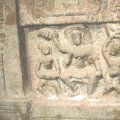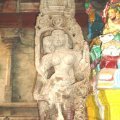Sculptures in temples in Kumbakonam: photo 488
Photo 488 of 640 in Gallery: Sculptures in temples in Kumbakonam

Image title: Figure 35. Three dancing figures–one female and two males
Description of the photo
Once again three dancing figures on a panel. One centre female figure and two male figures on her sides.
Centre figure–Siras is in Sama, Urah is in Sama. Kati and Parsva are all straight and unbent. She is in Mandala Sthana with both hands in Lata Hasta. Her left Pada is in Sama and in Parsva. Her right foot seems to be in Kuncita. She is wearing a bun on top of her head with locks of hair on the side of her face. Could be a part of a Karana like Dolapadam–Karana no.60. “A Kuncita foot is to be thrown up and moved side to side and dropped as Ancita foot and the two hands are swung from side to side in a graceful manner.”
Left figure–A male figure, with one hand on Kati and the other one raised up in Udvestita. The Siras is in Ancita. His Janu is slightly bent, Pada are in Sama both turned to one side. Right Uru is in Valana.
Right figure–Is also a male figure in Abhanga posture. Both Janus are in slight Ardhakuncita. Left hand is in Lata or Dola and the right hand is holding some object Camara. Pada are in Sama.
Both the male figures are also having buns on their head with locks of hair falling on the sides of their faces. Once again this sculpture brings out the practice of the main dancer being the female whereas she was accompanied by other artistes. It is the main dancer or courtesan who performed the Caris and Karanas.
Gallery information:
Kumbakonam is considered as one of the holiest places in Tamil Nadu and is known for its temples and Mathas (monasteries which were centres of Brahmanical learning). These photographs depict the connection between the sculptures in the temples and Natya Shastra and related texts dealing with iconography.
Photo details:
High resolution:
Download file
Size: 73.19 KB
Resolution: 744 x 558
© Copyright: see gallery source

